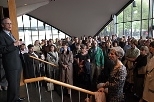A power outage that affected much of Cambridge for two hours on Monday afternoon turned the State of the Institute Forum into an unplugged, informal event.
About 150 people stood in the steamy lobby of Kresge Auditorium listening to MIT's top officials give an abbreviated version of the forum that had been scheduled for 2 p.m. in the auditorium.
A failure in a 115kv transmission line at the NStar substation on Putnam Avenue in Cambridgeport triggered a widespread city power outage beginning at 1:11 p.m. The Institute lost power instantly. Emergency backup generators kicked in 10 seconds later, providing emergency lighting to the main campus and, in larger buildings, ventilation. Power was fully restored to most of the campus by 3:20 p.m. and to the entire campus by 4 p.m., according to Peter Cooper, director of utilities for MIT.
Despite the outage, President Charles M. Vest, Provost Robert Brown and Executive Vice President John Curry headed over to Kresge through the rain in case people showed up for the forum. Surprisingly, many did. Because rescheduling the event would have been impossible given their own schedules, the trio decided to forge ahead, holding the forum in the glass-walled lobby, which provided subdued daylight if not A/C.
Staff members and a few students and faculty listened keenly, holding their water-soaked coats and umbrellas, as the three speakers strained to be heard without microphones over an alarm tone sounding from the other side of the lobby.
Vest told the attentive crowd that much of the strategic planning that the Academic Council had hoped for following a 1991 retreat now has taken place.
At that retreat, the Academic Council adopted the acronym NIRRD as an Institute goal, agreeing to make MIT a more "nimble, international, robust, resourceful and diverse" place.
"We are much more that kind of place today than we were in the early '90s," Vest told the group.
In discussing the Institute's current short-term financial difficulties, Vest, who announced in December his plan to step down as soon as a new president can be selected, said, "Our thinking behind this is we've got a problem--let's take the tough bite and get past it. We will hand over a good situation to the new person and new team."
The provost said that constraints should loosen a bit in next year's budget, including a lifting of the salary freeze. Although the cuts have brought "uniform pain" across MIT, we'll "move ahead in the next budget year," said Brown.
Ongoing capital construction projects will continue, said Curry. "We'll complete the building projects under way. We'll complete payroll," he said.
At the end of the one-hour session, Tom Hrycaj, administrative officer for the Plasma Science and Fusion Center and a member of the Administrative Advisory Council II (which organized the forum), thanked people for attending.
"At this moment, we know the state of the Institute--unplugged," Hrycaj said, provoking laughter from the crowd.
Elsewhere at the Institute, the food trucks had long lines, students and staff huddled under the little shelter available on the Student Center plaza, and small groups of students sat on the floor in Lobby 7 eating box lunches and chatting.
This was the first power outage on campus since Aug. 7, 1997, when an explosion in a manhole near Kendall Square killed an employee of the Cambridge Electric Co. (now NStar) and caused an evening-long outage.
Monday's transmisson line failure at NStar's Putnam station interrupted the power source to the power company's transformers, leaving much of Cambridge without electricity for about two hours. When that occurred, MIT's cogenerator pumped power back into Cambridge for a fraction of a second, causing the cogenerator's frequency to drop drastically and the unit to shut down almost instantly.
MIT gets most of its power from the campus cogenerator, which produces about 20 of the campus's required 28 megawatts; the remainder comes from the Cambridge power grid.
"Our emergency plan used to be to drop off the Cambridge grid the instant it started losing power, but with the increased power requirements on campus, we've changed our emergency plan," Cooper explained. "Now we hang onto the grid and go down with it, then start our blackout restoration procedure. Normally, we could start picking up power within 20 minutes and have it fully restored within an hour."
But yesterday, the process of restarting the cogenerator had to proceed more slowly than usual. Repairs to the plant planned for October will remedy that in future, Cooper said. Yesterday, NStar's power was available before the MIT cogenerator was back in operation, so NStar's power was used during the initial power restoration to campus. Power was fully restored to the campus at 3:50 p.m.
A version of this article appeared in MIT Tech Talk on May 5, 2004.






